ASDIC is the original British name for the equipment which sent sound pulses on specific bearings in order to detect submerged submarines. The acronym means Antisubmarine Detection Investigating Committee and whose origins began in 1918. SONAR is the American term used for the equipment to detect submarines and it got its name during WWII. The acronym means SOund Navigation And Ranging. Reference to ASDIC was still being used into the early 1960s. The year 1965 seems to be a watershed year in which the term SONAR became standard terminology thus generating other terms such as passive-sonar and active-sonar. The terms ASDIC and SONAR will be used ere depending on which is more historically appropriate.
The main components of a WWII era SONAR/ASDIC system are:
1) Sound pulse generating and receiving equipment.
2) An underwater transducer or oscillator of some type.
3) A dome to house the transducer or oscillator.
4) Recording/control equipment to indicate range, bearing and depth of the target.Besides detection, SONAR can then be used to control weapons like a depth charge launcher or Squid. The main searchlight beam was for long range detection of targets and was developed during WW1. The 'Q' attachment and type 147 ASDICs were secondary sets used for maintaining contact with deep diving submarines and were developed during WWII. The terms oscillator and transducer are used interchangeably here. Oscillator is the British term; transducer is the American term. Although physically different, the oscillator or the transducer perform the same function and they are the components of the system which get immersed in sea water.
Listed below are the SONAR/ASDIC systems which were identified as being fitted to HAIDA.
| NAME | DESCRIPTION | DISTANCE | IN SERVICE DATE | END DATE |
| 144 ASDIC | Main ASDIC set | 2,500 yards | 1943 | 195? |
| 1444 'Q' Attachment | Secondary set | 1,200 feet | 1943 | 195? |
| 147B Depth Finding Set. | Used in conjunction with 164B set | 1,000 feet | 1943 | 1963 |
| AN/SQS-10 | Scanning sonar. | 6,000 yards | 1952 | 1963 |
| AN/SQS-501 (also called type 162) | Sea Bottom Identification set | 1.800 feet | 1952 (?) | 1963 |
| 164B Range and Bearing Finding Set | For Ahead Throwing Weapons like Squid | 2,500 yards | 195? | 1963 |
| AN/UQC-1B | Underwater Telephone | 8,000 to 12,000 yards | 1960 | 1963 |
The in-service date for the 164B is problematic. According to the Imperial War Museum, the production years for the 164 set were 1956 and 1957. Assuming a best case procurement, that means that 164 was not aboard the ship until 1956 or possibly 1957. That leaves a gap in the SONAR chronology and also suggests that the 144Q may have stayed aboard ship until the 164 sonar was installed.A 1952 drawing shows the SQS-10 repeater display in the Operations Room, so that confirms the in-service date for that SONAR type.
144'Q' ATTACHMENT (1943-1949) No photo is available of the "Q" attachment The 'Q' attachment was an additional ASDIC set which required separate transmitting and receiving equipment suitably inter- connected with the main 144 set. Physically, the Q oscillator (transducer) was mounted beneath the main oscillator and trained with it. It projected a fan shaped beam that was narrower in the horizontal plane than the main ASDIC beam but sufficiently wide in the vertical plane to receive echoes at any angle from the horizontal to 45 degrees below horizontal. The beam was only 3 degrees wide on the horizontal plane. Collectively, ,it enabled contact to be maintained with deep targets at short ranges and also minimized the dead zone. The Q beam was transmitted through a window in the bottom fore part of the ASDIC dome. This arrangement also allowed the Q oscillator to be used at angles of up to 70 degrees from the bow. In shallow water, the Q beam would strike the bottom giving long drawn out echoes that appeared similar to heavy reverberations. This effect made the Q beam appear stronger than the main beam but the effect disappeared in deep water.
According to Norrie Millen (retired Royal Navy):
"I think under ideal conditions a range of 2800 to 3000 yards was possible with the 144 set , It all depended on sea state, water temperature, water salinity etc. Q and Q2 [attachments] were used for close range contacts"
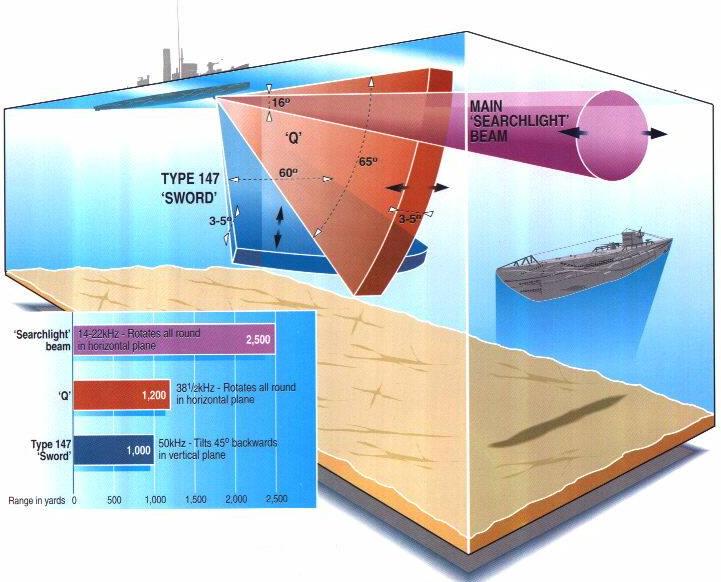 |
| In order to locate a submerged submarine, it was necessary to determine the range, the bearing and depth of the target .On-build, this was done with the 144Q and 147F ASDICS. This graphic gives some indication of how the beams looked. (Source: DDE220.com) |
| MODEL | FREQUENCY | DESCRIPTION | BEAM SHAPE | RANGE | TRAINING |
| 144 MAIN | 14 to 22 KHz | 15 inch transducer held in a vertical plane. | Conical | 2,500 yards | All around in horizontal plane |
| 144 Q | 38.5 KHz | Strip shaped transducer - 12 inches by 1 inch | Wedge shaped in horizontal plane | 1,200 yards | All around in horizontal plane |
| 147 "SWORD" | 50 KHz | Strip shape transducer - 4-5 inches wide by 4-5 feet long. | Fan shaped in horizontal plane | 1,000 yards | Tilted 45 degrees backwards in a vertical plane. |
A film on the general operation of the 144 ASDIC can be found here. (Via Imperial War Museum)
| 147B "SWORD" DEPTH FINDING SET (1943-1963) |
| No 147F photo is available at this time |
| The 147 type was a depth finding set that complemented the main
ASDIC set (144Q ) and the Q attachment. It's most notable feature
was its sword shaped oscillator operating at a frequency of 50 KHz. Physically,
the sword was four to five inches wide and approximately four to five feet
long. To prevent interference with the main set, the 147 was mounted ahead
of it. When not in use, the sword was stored in a lifting tube mounted
within the hull.
When deployed, the sword could project a fan shaped beam being narrow in the vertical plane and wide in the horizontal plane. It could be trained up to 65 degrees horizontally and 45 degrees vertically .This new design, which added depth determining capability, could accurately track a target within 20 feet. Another feature was its integration with Squid, an ahead-throwing Anti-Submarine (A/S) mortar. But Squid was not fitted to HAIDA until her 1949 - 1952 modernization. When an echo was received on a 147B set, the operator would tilt the sword until the echo was lost. He would then reverse the procedure until the echo was heard again, then continue sweeping until the echo was lost on the opposite end of the sweep. Every echo received would then be printed on the depth recorder. A line of light on the depth recorder would indicate the centre of the echo trace. The operator would then look at a calibrated scale and read off the depth directly in feet. From here, the information was used for setting the pistols on depth charge fuzes. In 1942, the minimum range for a lost contact was around 170 yards, As U-boats went deeper when attacked, the minimum range was about 270 yards in 1945. |
| AN/SQS-501 BOTTOM FINDING SET (1952? - 1963) |
| The AN/SQS-501 was an auxiliary set designed specifically for identifying
submarines lying on the ocean floor where the depth of water was not too
great. It could also be used to determine the depth of water under the
keel.
There were three, fixed, quartz transducers mounted in the forward end of the ship's hull. One unit faced port and another faced starboard. The third unit, mounted in the keel, faced straight down. In operation, either the port and keel or the starboard and keel transducers were used. They produced a sound beam at right angles to the ship's fore and aft line. This beam was fan shaped, being narrow in the horizontal and very wide in the vertical plane. A simple changeover switch provided a means of projecting the beam to port or to starboard. The recorder produced a shadow trace that gave a reasonably clear picture of the bottomed object. By application of a mathematical formula, it was possible to determine the length and width of the target. The transducers were mounted in hull fittings that were secured on the inside of the ship's hull. Another system equalized the pressure inside the fittings to that of outside sea water. This was accomplished with inter-connecting pipes between the hull mountings and a supply tank that was mounted inside the ship at water level. The liquid used in this system consisted of a mixture of water and glycerine. This prevented freezing and possible damage to the hull mountings in colder climates. Otherwise known as "Tracer" (RCN) or "Sounder" (RN), SQS-502 was functionally equivalent to type 162 sonar. |
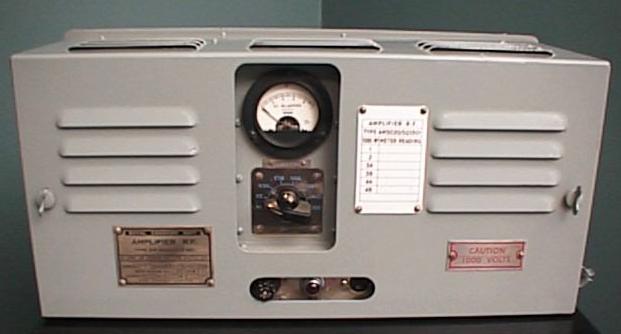 |
| A/N SQS 501 amplifier. This was just part of the system. (Photo courtesy of jtaudio@shaw.ca) |
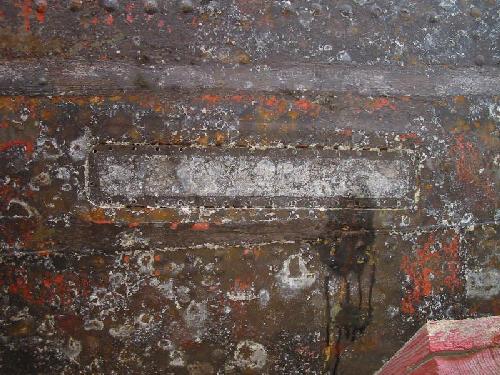 |
| The three hull openings for the SQS-501 transducers would have looked like this. This photo of HAIDA's hull was taken when she was in drydock in 2003. The hull has just been power washed, hence the visibility of hull pitting. (Photo by Jim Brewer) |
| AN/UQC-1B UNDERWATER TELEPHONE (1960- 1963) |
| The AN/UQC-1B equipment is designed for use in submarines and surface
ships tin order to provide voice or CW communication.
This device was an underwater communication set, or as it was more commonly referred to as an Underwater Telephone. It was designed for use in submarines and surface ships to provide amplitude modulated (AM) voice or CW (Morse code) communication through the water using a 8.0875 kHz carrier. The AM mode employed Single Side Band (SSB) using the upper side band (USB). The useable range varied between 8,000 to 12,000 yards depending on ship's speed and sonar conditions. That is the range quoted for the 'A' and 'B' variants. Morse code used a fixed audio note of 712 Hz. Personnel stationed on the ship's bridge used a telephone like device when communicating on voice. A small, cylindrical, magnetostriction transducer was fitted in the sonar dome, aft of the main set. A combined receiver-transmitter panel was fitted in the Sonar Equipment compartment while the 'sonar set remote control unit (SSC-RCU) was mounted at either the command position on the bridge or in the operations room. The SSC- RCU contained a power off/on switch for the set, a loudspeaker with volume control, a Morse key, a phone/CW switch and a microphone. The UQC-1B gear was housed in the Sonar Equipment compartment which is on the forward mess deck. The transducer for the UQC-1B was located in the sonar dome. A hand written note on one of the source documents for this device indicates that the RCN ordered 45 sets on the initial procurement. HMCS Haida was fitted with the AN/UQC-1B at the time she was paid off. The in-service date for the fitting of UQC-1B in HAIDA is a bit uncertain. Here are the production dates for the variants. UQC-1A - March 1958
|
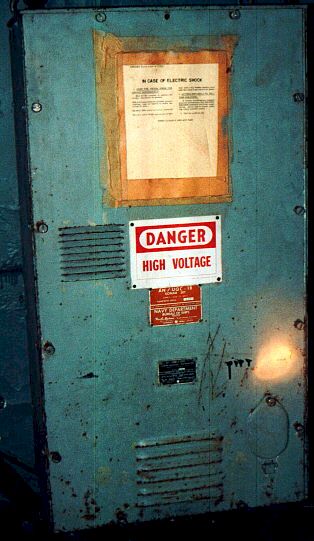 |
| Not much to see on the exterior of the AN/UQC-1B. This example has certainly seen better days. .(Photo courtesy of Destroyer Escort Central web page http: //www.de220.com) |
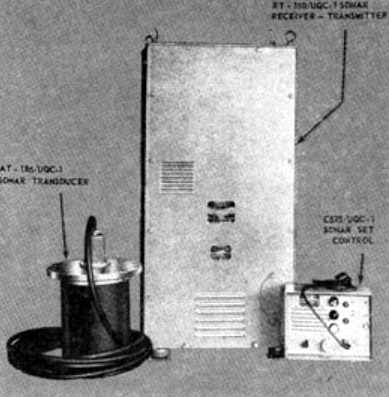 |
| These are the principal parts of the AN/UQC-1B system. From left to right: Transducer with cable, Receiver-transmitter cabinet and the control unit (Maritime Park Association) |
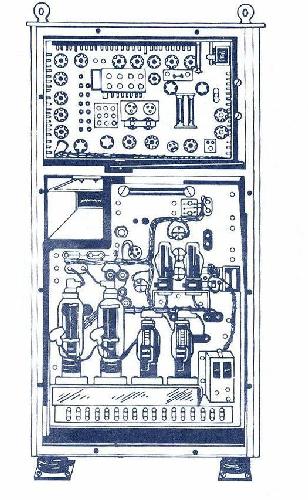 |
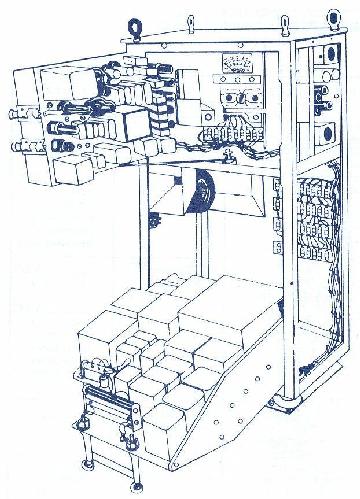 |
| AN/UQC-1B: Front view of the receiver-transmitter cabinet with the service panel removed. (Graphic courtesy of RCA Victor) | AN/UQC-1B: The receiver-transmitter cabinet with both chassis swung down for servicing. (Graphic courtesy of RCA Victor) |
| HULL OUTFITS |
| The enclosure in which oscillators or transducers were fitted was called a hull outfit and more commonly called a sonar dome. |
 |
| This is a cutaway view of a WWII era ASDIC dome and approximates the placement of the main oscillator (transducer) for the 144Q ASDIC. It is not known if HAIDA's dome was identical in appearance. (Image source unknown) |
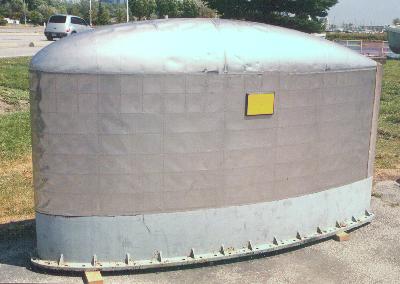 |
| Hull outfit 7A. This SONAR dome, known as “HULL OUTFIT #7A”
was part of HAIDA’s SONAR system and would be found under the hull about
one third the length of the ship. Three transducers were mounted
within the Hull Outfit. The exterior of the Hull Outfit is clad with
a special type of stainless steel called Staybrite. Normally, the dome
is retracted when the ship is in shallow water or in harbour. When SONAR
is to be used, the dome is lowered from its retracted position. It then
floods with sea water, thus permitting the passage of the transmitted
sound pulse and reception of echoes. In the above photo, the hull outfit
is being displayed in the inverted position.
SONAR could not be used if the ship was travelling over 15 knots because the water flowing over the Hull Outfit would produce noise and mask the echoes.. (Photo by Jerry Proc) |
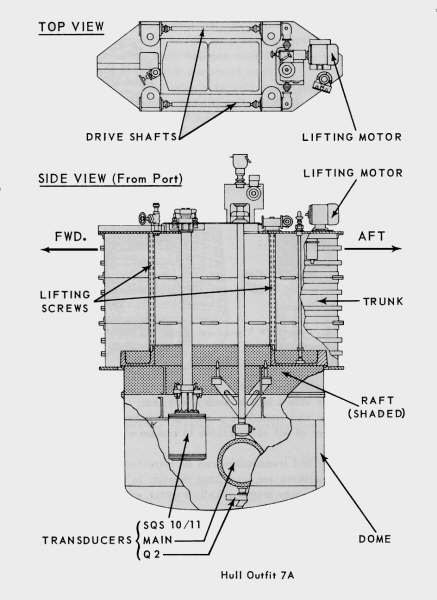 |
| Cutaway view of Hull Outfit 7A showing the dome hoist. It approximates the placement of the transducers for the AN/SQS-10 and Type 164 SONARs and the AN/UQC-1B underwater telephone. (http://www.hazegray.org/navhist/canada/systems/sonar/) |
| The somar dome hoist was used to deploy or retract the sonar dome. |
| If the ship was in drydock, and the sonar was in need of maintenance,
the dockyard mateys would drop the dome and work on it in that way.
If the ship was in the water and not accessible to a dry-dock,
then the crew would work on the transducers by going in from the top.
It is believed that the transducer for the AN/SQS-10 sonar weighed over
400 lbs.
When the dome was in the up position there was a seal that allowed the inside cover of the dome to be removed without the ship filling full of water. That was one way of exchanging a bad transducer. |
| This winch could be used to lift the sonar transducer element(s) from the housing It was used in conjunction with the heavy duty pulley to the right. | When it was necessary to swap a transducer, it could be lifted up through holes in the mess decks above. These holes were in alignment with the winch. with the winch. |
SONAR CONTROL ROOM
 |
| HAIDA'S Sonar Control Room as it appeared in 2007. It would have been staffed by four operators and was located on the Flag Deck, port side, next to the Operations Room. (Photo by Jerry Proc) |
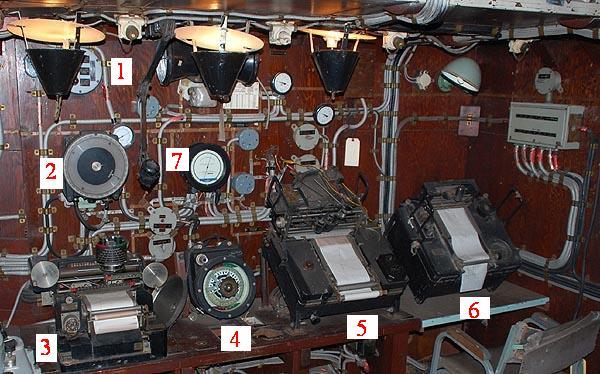 |
| Equipment n this photo:
1) Dome locator. It has three indicator lights: up--moving--down.
Three, small, circular gauges mounted to the plywood bulkhead do not belong there. These are pressure gauges and were mounted for a movie shoot. They have never been taken down. The AN/SQS-10 operator's console would have been at the aft bulkhead of the Sonar Control Room. It was removed from the ship by the Navy when HAIDA paid off. There was also a repeater for it above the VK5 PPI in the Operations Room. Out of view is the AN/SQS-501 recorder which was mounted on the starboard bulkhead in the Operations Room. |
To hear pinging from a real sonar, select this link (168 kb wav file). What you are hearing consists of a transmission, followed by an echo after 3 seconds. This is repeated a second time. It therefore takes 1.5 seconds for the sound to reach the target. The returning echo after 3 seconds corresponds to a contact approximately 2,400 yards away (Calculation: The speed of sound in water is approximately 4,800 feet per second multiplied by 1.5 seconds = 7,200 feet or 2,400 yards). File courtesy of Keith Wilbur.One of the four sound systems fitted in the ship was in the Sonar Control Room. It was the Admiralty Pattern AP 12523 type 366 and located next to the power supply for the VK5 radar repeater.
Contributors or Credits:1) https://acoustics.ac.uk/wp-content/uploads/2018/08/D1_WHackmann_History.pdf
2) Sonarman Trade Group 1 Manual. RCN. 1963
3) http://www.hazegray.org/navhist/canada/systems/sonar/
4) Jim Brewer <snack.235(at) sympatico.ca
5) http://rnsubs.co.uk/articles/development/sonar.html
Jan 15/21